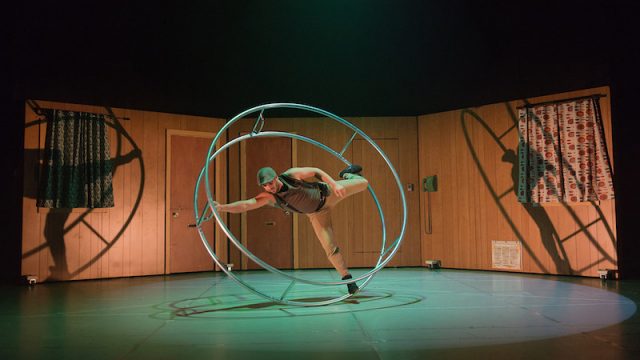Review from: Assembly Rooms, Edinburgh Festival Fringe; 12th August 2018

A battered wall stretches across the stage, two doors, two windows. Like a cheap American motel from the movies. A line of performers enter, each offering a eulogy to an unknown person into a microphone at centre of stage. Each remembering their own grandparent, perhaps? Ensemble choreography of entering and departing through doors and windows, frantically acted initially, then increasing in acrobatic enactment of the frantic feel. Appearances over and above the wall become an option. This is a good venue choice, allowing considerable stage space and audience proximity.

As you would expect from the 7 Fingers, individual skill levels are high. Some of the staging devices in this new show feel a little dated though. A Spanish speaking woman can’t find her key and becomes an object of fun, which seems a bit of a dodgy choice as hers is the only non-English speaking role and we are encouraged to laugh at her in her difference. A man sweeps the floor. Is a broom still a logical reason for someone to be somewhere? The flat walls are reversible (is that where the name comes from?), but ‘indoors’ is as much a place for other bodies to suddenly appear as ‘outdoors’.
Maria Del Mar Reyes‘ hand-balance act is the first of the numbers that emerge from the shifting sets. She’s given physical encouragement to start from the ensemble, and they further fill the stage space with synchronised movement while she performs on canes. Her twisting solo floor dance spot is emotive in a way her cane work isn’t, and the contemporary dance skills of this company are particularly notable.

Emi Vauthey is a hoop dancer and contortionist with a strong presence, performing fast contact work and ghosting with the same earnestly emoting face all the company display. There’s a small round mirror on the back wall of the set which gives a great set of reflections for a moment, but is under-utilised.
Hugo Ragetly keeps being shut out of the moving doors, and this leads into a sequence of people being thrown of the house-fronts by supposed lovers. A gratuitous f-word is thrown out, and gets the laugh it was designed to elicit.
Julien Silliau performs a Chinese pole duet with Del Mar Reyes , while other couples play out choreographic relationship scenes. Del Mar Reyes wears flesh coloured leggings instead of the usual thick trousers, and it makes my skin pinch just watching, especially when she grips her legs above her head and suspends Silliau by the wrists.

At this point, any thematic beyond people existing is lost on me, but that doesn’t stop me enjoying the disjointed skills of the individual acts when they appear. Natasha Patterson is a highlight as she juggles a large red rubber ball with dynamic choreography, the balls increasing in number as the sets shift around her. A section where she is wedged into a doorway with five balls around her is over much too soon, but another treat is in store as she momentarily becomes a Banksy painting come to life.
Silliau spins a German wheel hard and fast like the now more commonly seen Cyr – including a back coin – while a voice over narrates biographical details of more past lives.

Vauthey appears, caught up in a voluminous wedding dress, which makes for an unusual and amusing display of her contortion talents. I remember her original funereal story was about a woman who ran away from a forced marriage. Maybe all these numbers represent the stories they started telling?
A teeterboard hidden behind the building flats leads to hide and seek interactions with the set from Vincent Jutras and Jérémi Levesque. The sets are swivelled so they’re in full view and, though their trick level increases in drama, the routine loses some of its interest once the playful gimmick is removed.

A washing line strung across the stage is hung with floral bedsheets and dated bedclothes and Ragetly tosses five balls in high patterns, or two balls in low close throws around his body parts. As his sweater is removed and hung on the line, it’s a reminder that we are all mortal, and will all be but a memory one day. He inhabits a nightdress for a final seven-ball flash and, with a rumble of thunder, a billowing cloud of parachute silk covers the stage. The cast joyfully romp over and under the pearly fabric, troubles past.

Some spoken text earlier in the show talks about fragments of a story that will never be complete, which seems to be the overall dramaturgical motivator. Whilst stories of departed grandparents should have the sentimental capacity to reach everyone, I find myself surprisingly unmoved by the talent onstage. What they present is slick and skilled, but Réversible is an indication that the 7 Fingers are far from the cutting edge they once were.
.




